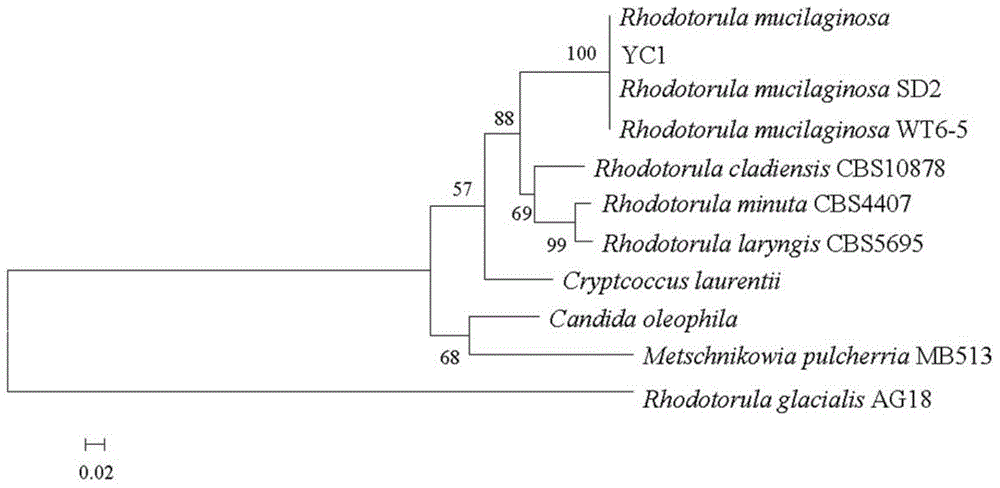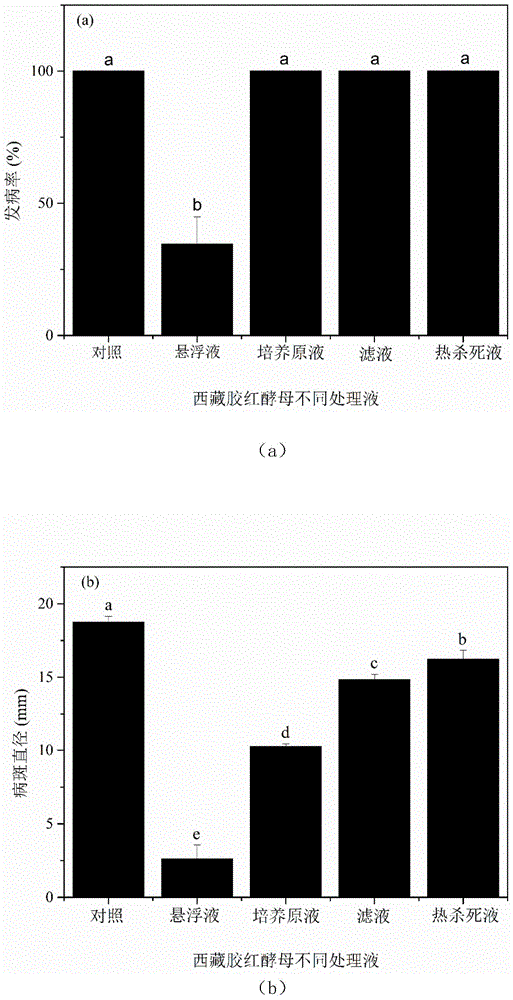Tibet rhodotorula mucilaginosa and application of Tibet rhodotorula mucilaginosa to low-temperature storage of crystal pears
A gelatinous red yeast, low-temperature storage technology, applied in the fields of application, fruit and vegetable fresh-keeping, and microbial-based methods, to achieve low cost, good anti-corrosion and fresh-keeping effect, and increase income
- Summary
- Abstract
- Description
- Claims
- Application Information
AI Technical Summary
Problems solved by technology
Method used
Image
Examples
Embodiment 1
[0047] Example 1, the control effect of different concentrations of Rhodotorula japonicum on crystal pear low-temperature storage penicillium
[0048] Choose fruits with normal commercial maturity, which are required to be plump and round, with a neat appearance, no dryness, no mechanical damage, and no disease. The tested pear variety is crystal pear (Pyrus pyrifolia Nak.), and the fruit is picked at the commercial maturity stage, and immediately transported to the laboratory for processing after picking, or stored at room temperature (20°C-25°C), relative humidity 92-94% environment Medium, use within 48h.
[0049] The fruit pretreatment steps are as follows: soak and disinfect with 0.1% sodium hypochlorite (NaOCl) solution for about 1 minute, rinse repeatedly with tap water, and finally dry at room temperature for use.
[0050] The antagonistic yeast is Rhodotorulamucilaginosa YC1 (CGMCC No.10223), and the yeast preserved on the slant (take 1 ring of the inoculation loop) ...
Embodiment 2
[0054] Example 2 Control effect of different treatment solutions of Rhodotorula japonicum from Tibet on penicillium in low temperature storage of crystal pears
[0055] Choose crystal pear according to the requirement of embodiment 1.
[0056] The preparation methods of different treatment solutions of Rhodotorula tibetan are as follows:
[0057]After activation of the yeast strain R.mucilaginosaYC1 (one inoculation loop was taken), it was inserted into a conical flask containing 50mL NYDB, and cultured at 28°C and 200r / min for 24h. The fermentation broth was collected by centrifugation at 3500 rpm / centrifugation for 10 minutes; the yeast cells were washed with sterile water, counted with a hemocytometer, and then prepared into the following treatment solutions:
[0058] (1), yeast cell suspension, adjust the bacterial body to a concentration of 1 × 10 with sterile water 8 cells / mL;
[0059] (2), get the supernatant obtained by above-mentioned centrifugation, and filter thr...
PUM
 Login to View More
Login to View More Abstract
Description
Claims
Application Information
 Login to View More
Login to View More - R&D
- Intellectual Property
- Life Sciences
- Materials
- Tech Scout
- Unparalleled Data Quality
- Higher Quality Content
- 60% Fewer Hallucinations
Browse by: Latest US Patents, China's latest patents, Technical Efficacy Thesaurus, Application Domain, Technology Topic, Popular Technical Reports.
© 2025 PatSnap. All rights reserved.Legal|Privacy policy|Modern Slavery Act Transparency Statement|Sitemap|About US| Contact US: help@patsnap.com



